| Fort Schneider Purdy's Farm, Annandale, VA |
|
by Debbie Robison January 24, 2014 |
During the Civil War, Annandale Virginia was fortified to help protect
Washington, D.C. from Confederate guerrilla attack. A stockade-type fort was
constructed in the summer of 1864 adjacent to the Little River Turnpike on a
rise east of Accotink Creek. The fort was named Fort Schneider after Joseph
Schneider, Captain in the 16th New York Cavalry and commander of the
stockade.[1]
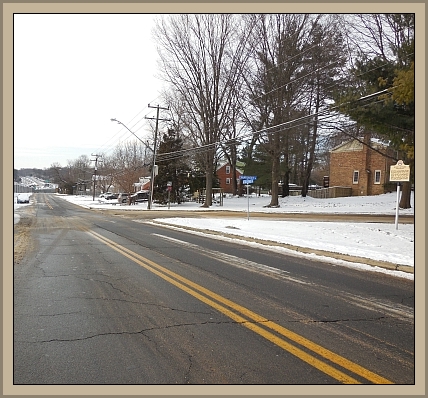
|
| DEFENSIVE STRATEGY |
The fort was proposed by Colonel H. M. Lazelle, 16th New
York Cavalry, Commanding Brigade, on July 19, 1864 after his force was reduced
when the Second Massachusetts Regiment Cavalry departed for Washington City.
Lazelle, who was responsible for overseeing observations of the enemy’s
movements up to the eastern side of the mountains, recommended a new defensive
strategy that was better adapted to his available strength (i.e. number of
troops). His scheme was to construct two defensible stockade forts, one at
Annandale and one near Lewinsville. The Annandale stockade would control the
Little River Turnpike and the Lewinsville stockade would guard two nearby
turnpikes. Three companies (one of which would be mounted) would be assigned to
each stockade. The remaining force, placed in a defensible camp near Falls
Church to control Falls Church village and the railroad, would constantly
patrol between the camp and the two forts.[2]
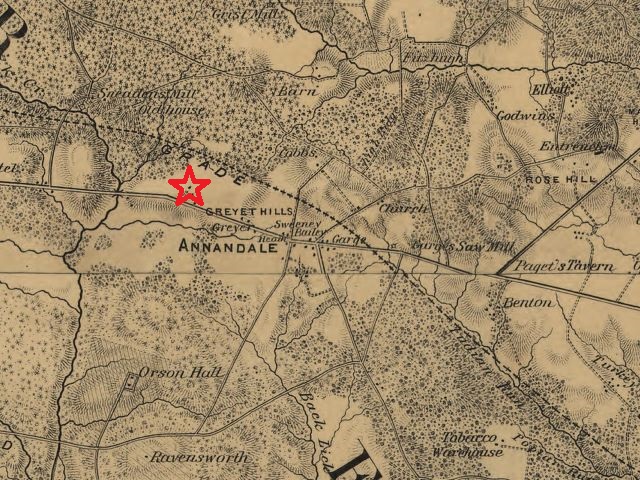
|
| PURDY’S FARM |
Fort Schneider was located on the land of James S. Purdy, a northern
man who was one of four who voted in his precinct against Virginia’s Ordinance
of Secession.[4]
Purdy’s family and property suffered during the war due to the strategic
location of his 318-acre farm. Purdy described his losses in a claim filed with
the Southern Claims Commission. Purdy stated that at the beginning of the war, he
furnished Union General Mansfield, the U.S. Provost Marshall at Alexandria, and
the Captain of nearby cavalry pickets with information on the movement of
Confederate soldiers. Knowing that Purdy was for the Union, the Confederates
searched his house and tried to capture him but he escaped to Washington. He
was threatened that if caught he would be killed rather than taken to Richmond.[5]
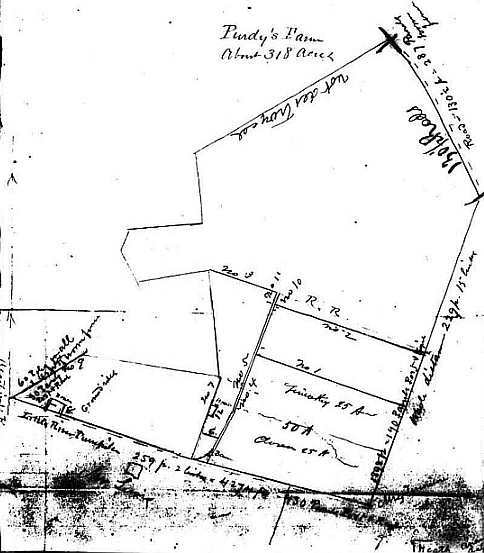
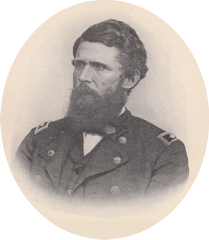
|
| Lafayette C. Baker |
About 3,000 trees, averaging 10” in diameter, were felled on Purdy’s
property by the 16th NY Cavalry for use in construction of the
stockade and abatis.[10]
An abatis was constructed at this site prior to construction of the stockade. Construction
of the fort began in July 1864.[11]
It likely encircled Purdy’s barn, which was used by the 16th NY Company
C as a stable for sick horses.[12]
On September 1, 1864, after an unsuccessful Confederate artillery attack,
Captain Schneider requested assistance with completing his stockade and abatis.[13] That
winter, additional timber was cut from Purdy’s farm for the construction of
winter cabins.[14]
The barn was pulled down for use in making sheds for horses and for use by a
detachment of the 5th Pennsylvania Heavy Artillery for building
winter quarters.[15]
The entire occupation embraced an area on Purdy’s farm of about 15 acres.[16]
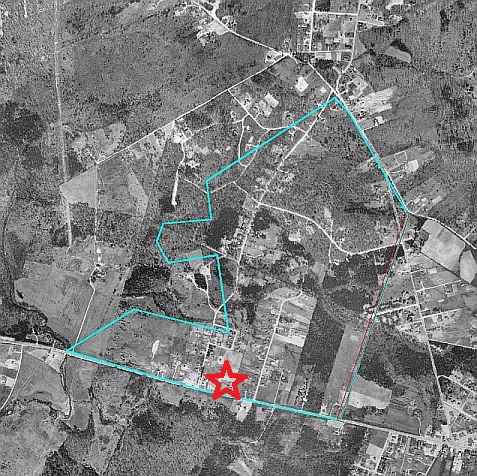
|
| ATTACK ON FORT SCHNEIDER |
Early on the morning of Wednesday, August 24, 1864, the camp at the
Annandale stockade heard three warning shots fired by the picket on the Little
River Turnpike in advance of a Confederate attack. The fort, which was
positioned on a knoll, first came into view by the Confederates when they were
at the top of a hill about half a mile to the west. A valley was situated
between the Confederates and the fort.[17]
About 100 Confederates charged towards the entrance of the fort, but swerved to
the south and east when then were met be a volley. At the time, the stockade
held 170 northern troops of the cavalry battalion.[18] A flag of
truce was brought forward by the Confederates with a demand for surrender in
the name of Colonel Mosby. Under the flag of truce, they advanced two field
artillery pieces within 300 or 400 yards of the camp, one on the southwest and
one on the northwest. When the surrender was rejected, they began to fire shell
and grape shot into the fort. Two more requests for surrender, also issued
under flags of truce, were rejected. The last time a flag of truce was sent,
the bearer was informed that if they sent a flag of truce again they would be
fired upon.[19]
The attack lasted almost one and one half hours during which time the
Confederates fired from thirty to forty cannon shots. Union troops were
reported to have taken refuge in their bomb-proofs.[20] The
Confederate attack was unsuccessful, they claimed, due to the poor angle they
had for firing into the fort. They wounded two horses, but for the most part
their shots were ineffective. At the conclusion of the attack they retreated down
the turnpike toward Fairfax Courthouse.[21]
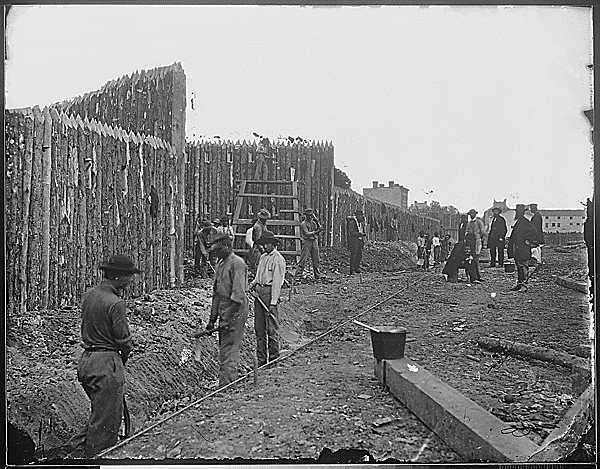
|
| IN THE END |
| James Purdy moved to New York an impoverished man. William H. Gooding, who owned the land that is now the Annandale Campus of the Northern Virginia Community College, sold the stockade and abattis for $150 in July 1865.[22] Purdy sold his farm in 1871.[23] He was successful in obtaining some of the funds he requested from the Southern Claims Commission as compensation for war-time losses, though he had difficulty proving portions of his claim due to his difficulty in obtaining accounts caused by the imperfect language skills of the German troops stationed on his property.[24] |
| ENDNOTES |
|
[1] Boston Evening Transcript, August 16, 1864, p4; New York Times, August 16, 1864. [2] United States War Department, “Report of Brig. Gen. John Newton, U. S. Army,” The war of the rebellion: a compilation of the official records of the Union and Confederate armies, as viewed on http://ebooks.library.cornell.edu (Hereinafter referred to as Official Records), Chapter XLIX, July 19, 1864, pp. 387-390. [3] Official Records, Report of H. M. Lazelle, Colonel Sixteenth New York Cav., Comdg. Brig to Lieut. Col. J. H. Taylor, Chief of Staff and Assistant Adjutant-General, Chapter XLIX, July 19, 1864, pp. 387-390. [4] Southern Claims Commission, Claim of James Purdy; Records of the Ordinance of Secession, Fairfax County Circuit Court Archives, Fairfax, VA; Federal Census of 1860 for James S. Purdy. [5] Southern Claims Commission, Claim of James Purdy, as viewed on ancestry.com [6] Southern Claims Commission, Claim of James Purdy, as viewed on ancestry.com [7] Southern Claims Commission, Claim of James Purdy, as viewed on ancestry.com [8] Southern Claims Commission, Claim of James Purdy, as viewed on ancestry.com [9] Lafayette C. Baker, History of the United States Secret Service, published by L. C. Baker, Philadelphia, 1867, pp. 197-200. [10] Southern Claims Commission, Claim of James Purdy, as viewed on ancestry.com. [11] Official Records, Correspondence of H. M. Lazelle, Colonel Sixteenth New York Cav., Comdg. Brig., to Lieut. Col. J. H. Taylor, Chief of Staff and Assistant Adjutant-General, Chapter XLIX, July 28, 1864, pp. 481-2. [12] Official Records, Report of Capt. Joseph Schneider, Sixteenth New York Cavalry, Chapter LV, August 25, 1864, p. 638. Also Southern Claims Commission, Claim of James Purdy, as viewed on ancestry.com. [13] Official Records, Correspondence of J. Schneider, Capt. Sixteenth New York volunteer Cavalry, Comdg. Stockade to First Lieut. Edwin Y. Lansing, Actg. Asst. Adjt. Gen., Cavalry Brigade, Fort Buffalo, Va., Chapter LV, September 1, 1864, p. 4. [14] Southern Claims Commission, Claim of James Purdy, as viewed on ancestry.com [15] Southern Claims Commission, Claim of James Purdy, as viewed on ancestry.com [16] Southern Claims Commission, Claim of James Purdy, as viewed on ancestry.com [17] James Joseph Williamson, Mosby’s Rangers, Second Edition, Sturgis & Walton Company, New York, 1909, pp. 218-221. [18] Official Records, Report of G. A. De Russy, Brigadier-General of Volunteers, Chapter LV, August 24, 1864, p. 900. [19] Official Records, Report of H. H. Wells, Lieutenant-Colonel and Provost-Marshal-General, August, 24, 1864, pp. 637-638 [20] James Joseph Williamson, Mosby’s Rangers, Second Edition, Sturgis & Walton Company, New York, 1909, pp. 218-221. [21] Official Records, Report of Capt. Joseph Schneider, Sixteenth New York Cavalry, Chapter LV, August 25, 1864, pp. 638-639. [22] Southern Claims Commission, Claim of James Purdy, as viewed on ancestry.com [23] Fairfax County Deed Book M4(91)270, James S. Purdy to Christian Seaman, March 22, 1871. [24] Southern Claims Commission, Claim of James Purdy, as viewed on ancestry.com |

| Home |
 |
| © Debbie Robison, unless otherwise noted. All rights reserved. |